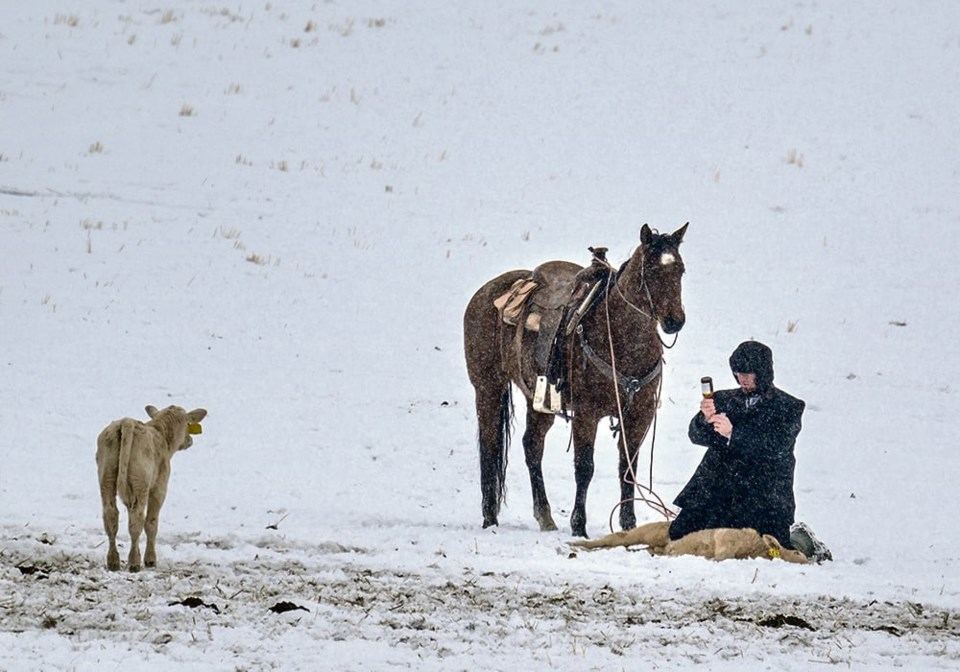WESTERN PRODUCER — Timely vaccination of cattle can build immunity before they are exposed to illness.
A calf acquires initial antibodies from colostrum, but once this passive immunity wanes, the calf’s own immune system must be stimulated with appropriate vaccinations to develop its defenses.
Dr. Eugene Janzen, professor emeritus at the University of Calgary, says the biggest difficulty for many producers and their veterinarians is sorting through the various recommendations.
“When talking about how to help a calf develop adequate immunity, we have to realize that one size does not fit all,” he says.
“The thing we often overlook is risk. Routine recommendations include certain vaccines for the cow prior to calving to control calf scours. If it’s a farm where cows are calving in a corral, this is appropriate.
“But if they are spread out on big pastures later in the spring, on grass instead of mud and manure, calves are not at such great risk.”
Calf vaccinations are generally given at branding time and again at weaning. If calves are abruptly weaned and then sold, a vaccination program benefits the buyer. In that case, it might not be worth the expense and effort to vaccinate and wean calves ahead of sale unless there is a premium paid for that preconditioning.
“If producers don’t have at least 250 cows, to have a liner load of steer calves, it is difficult to encourage them to vaccinate calves ahead of weaning,” says Janzen, because low numbers don’t entice a buyer to pay for preconditioning.
“Today, I see more calves sold on the internet or through a broker. They might be sold the first week in September for delivery mid-October, avoiding the auction yard,” he says.
This eliminates a major risk since commingling animals from various sources can expose them to disease. There is potential exposure to pathogens the calves have not yet encountered and the stress of transport, handling, strange environment and commingling can hinder the immune system.
“If there is very little or no commingling, this changes the level of risk and you might not need to be as intense in your vaccination program. There is also controversy about which vaccines are most effective,” says Janzen.
“If you take cattle to a community pasture, you would vaccinate them a different way. Dr. Amelia Woolums (Mississippi State University) has described how various factors can possibly lead to summer pneumonia in calves,” adds Janzen.
If people are using artificial insemination and gather cattle in midsummer to do so, it can expose calves to dust and respiratory disease.
“We can’t make general recommendations about vaccinating calves. It’s often up to the veterinarian who knows that client’s operation, to give specific advice and make a plan for that group of cattle. It all depends on what they are doing,” Janzen says.
“Many ranchers gather their cattle three to four weeks before weaning and vaccinate them. This is actually boosting the immunity from earlier vaccination if they gave those vaccines at branding time.”
However, branding has become controversial as a humane issue. Janzen says some producers wonder if they can do all procedures at birth, eliminating the need to vaccinate at branding.
However, antibodies from colostrum might interfere with vaccines. Since the calf already has antibodies, the immune system sees no need to respond to the vaccine.
“In spite of this, however, there is some evidence that the body remembers. Even if the calf is not at risk for those diseases in the summer, and doesn’t develop a great response, vaccination stimulates a little memory,” says Janzen.
Then the next vaccination acts as a booster.
“Cattle producers might use different vaccines under certain conditions, taking risk into consideration regarding when to vaccinate. If you vaccinate a baby calf, you may not get a strong titer, but you’ll get enough response to provoke the immune system into remembering it in the fall when you vaccinate that calf again.”
Level of disease risk is the first thing to consider when looking at calf immunity, says Janzen. Research shows a baby calf can be vaccinated, either intra-nasally or by injection, and its immune system will respond.
All calves at any age are at risk for clostridial diseases, so these should always be included in a calf vaccination program.
“Probably the only thing calves are truly at risk for in just about any situation is clostridial diseases like blackleg, malignant edema, redwater, etc.,” says Janzen.
All of those can be fatal.
The question is whether to vaccinate at birth, since the cow has been exposed to those pathogens, either naturally or through vaccination, and provides antibodies in colostrum.
Clostridial disease can also occur when herds have problems with liver flukes. If the liver is damaged by flukes, the animal is at risk for redwater. In this situation all cattle must be vaccinated once or twice a year with a clostridial vaccine. Castrating calves using the banding method presents a risk of tetanus so a clostridial vaccine is advised.
Janzen says a vaccine program must be tailored to each operation.
“I’ve been to veterinary clinics that have four or five different scenarios posted on a white board, and the recommended vaccination recipe under each one of those. Sometimes even the receptionist at the counter is very familiar with what each individual producer-client needs. They’ve been there long enough to know what works for each client.”

